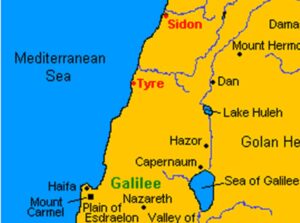 After His argument with religious leaders over what is to be considered “clean” or “unclean”, Jesus departs for a pagan region,Tyre – an unclean region – to minister to the Gentiles there.
After His argument with religious leaders over what is to be considered “clean” or “unclean”, Jesus departs for a pagan region,Tyre – an unclean region – to minister to the Gentiles there.
Here is the video link
Mark 7:24-37… Back to the Gentiles… Again
The audio links for iTunes and Spotify are to the right.
Here is the transcript used for today’s podcast:
Mark 7: 24-37
Jesus travels into Gentile territory
24 Jesus left that place and went to the vicinity of Tyre.[g]
After His confrontation with the religious leaders concerning clean and unclean, Jesus traveled into the midst of an unclean Gentile region.
Mark tells us that after this interchange, Jesus and the disciples withdrew from Galilee to the “region of Tyre and Sidon” (Mark 7:24). The evangelist does not explain why Jesus did this, but it is reasonable to speculate that our Lord was seeking to avoid a threat of some kind that would send Him to His death before it was time. One commentator notes that it may be that Herod Antipas, believing that Jesus was his old enemy John the Baptist come back to life, was looking to capture our Savior. In any case, Tyre and Sidon were Gentile regions, so Jesus and the disciples moved into areas that most Jews would have considered unclean. The region in which these cities were located had a long history of paganism and opposition to the Jews. For instance, the wicked queen Jezebel, who incited Ahab to worship the false god Baal and persecuted Elijah the prophet, was the daughter of the Sidonian king (1 Kings 16:31–32).
Galilee, which should have been friendly territory to Jesus, the Jewish Messiah, proved hostile because of the influence of the Pharisees and scribes. Tyre and Sidon, which should have been hostile to Christ given the history of God’s people, would be much friendlier to Him. There, we will see, people responded far more readily in faith to Jesus than the Jews did (Mark 7:24–8:10). It remains true that some of the quickest to trust Christ are those whom we might consider the least likely to believe. Such is the wisdom of God.
That Jesus went into a region that would have been expected to be hostile to Him is instructive to us. We are not to avoid those persons who appear to be most unlikely to believe the gospel. Instead, we must preach to them as well, trusting in the Lord to change their hearts. We must preach the gospel to all people, not just those whom we see as most likely to believe in Jesus.
© Ligonier Ministries [2016]. Used by permission of Ligonier Ministries. Source: [https://www.ligonier.org/learn/devotionals/jesus-visits-tyre-and-sidon#:~:text=In any case, Tyre and,and opposition to the Jews.]
He entered a house and did not want anyone to know it; yet he could not keep his presence secret. 25 In fact, as soon as she heard about him, a woman whose little daughter was possessed by an impure spirit came and fell at his feet. 26 The woman was a Greek, born in Syrian Phoenicia. She begged Jesus to drive the demon out of her daughter.
27 “First let the children eat all they want,” he told her, “for it is not right to take the children’s (i.e. Israel) bread and toss it to the dogs (i.e. Gentiles).”
An odd response, since He had purposely traveled to this Gentile territory. What would His purpose be if not to proclaim the Gospel? And why would He apparently try to dismiss her in this manner? I honestly cannot tell you. What I DO get is a sense that Jesus is drilling down to demonstrate her faith to those who are watching this scene unfold. The woman is not insulted by this response, nor is she deterred, as seen by her response.
28 “Lord,” she replied, “even the dogs under the table eat the children’s crumbs.”
I love this response of hers! I don’t know if she was aware of what was happening with Jesus in Israel or not, but what struck me was the fact that Israel (for the most part) was throwing away the food offered by Jesus (i.e. redemption), and this Gentile Pagan woman was more than willing to eat from the food that Israel was tossing to the floor. Many – if not most – of the Pharisees and teachers in Israel rejected the food offered by Jesus, yet this Gentile woman saw the value of what Jesus brought. I imagine Jesus nodding His head and smiling as He responded to what she said:
29 Then he told her, “For such a reply, you may go; the demon has left your daughter.”
30 She went home and found her child lying on the bed, and the demon gone.
This event in Tyre is in itself a parable of the change coming – the day when Jew and Gentile would stand on equal footing before God, both eating at His table, when there would be, as Paul says in Galatians:
Galatians 3:28 … neither Jew nor Gentile, neither slave nor free, nor is there male and female, for you are all one in Christ Jesus.
Jesus Heals a Deaf and Mute Man
31 Then Jesus left the vicinity of Tyre and went through Sidon, down to the Sea of Galilee and into the region of the Decapolis.[h] 32 There some people brought to him a man who was deaf and could hardly talk, and they begged Jesus to place his hand on him.
33 After he took him aside, away from the crowd,
Jesus does not require an audience nor does He need to produce a spectacle when He heals someone. He healed the Tyre woman’s daughter long distance, without even going to her bedside. Here He takes the deaf-mute man away from the crowd to heal him.
Jesus put his fingers into the man’s ears. Then he spit and touched the man’s tongue. 34 He looked up to heaven and with a deep sigh said to him, “Ephphatha!” (which means “Be opened!”). 35 At this, the man’s ears were opened, his tongue was loosened and he began to speak plainly.
36 Jesus commanded them not to tell anyone. But the more he did so, the more they kept talking about it. 37 People were overwhelmed with amazement. “He has done everything well,” they said. “He even makes the deaf hear and the mute speak.”
The thought occurs to me that the common man/woman had an easier time accepting Jesus than the religious leaders of His time did. The ordinary folk heard Him speak and saw Him work, and believed. The religious leaders thought more of THEIR words than His, and their mistaken understanding of His pedigree caused them to turn from anything He said and from anything He did. In their eyes, He was a mere carpenter from Nazareth. He was the illegitimate son of Mary, therefore nothing He said or did would be considered worthwhile. Yet the common man/woman heard Him, saw Him and believed.
Undoubtedly for Mark the significance of this miracle was the proclamation of the Gospel in the territory of the Gentiles, a sign of the messianic activity of Jesus.
Reference: Barker, K. L., & Kohlenberger, J. R. (2004). The Expositor’s Bible Commentary, Abridged Edition. Zondervan.
Blessings!
Paige

Mark 7:24-37… Back to the Gentiles… Again
VIEW THE COMMENTS